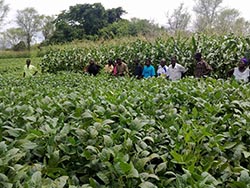My research started as a legume agronomist at the International Institute of Tropical Agriculture in Malawi. Two years of on-farm participatory research with smallholder farmers resulted in two publications. The first paper ‘Participatory research to close the soybean yield gap on smallholder farms in Malawi’ was published in Experimental Agriculture in 2016. A combination of inoculation, inorganic fertilizer (10 N, 8 P, 20 K in kg ha-1), and 6 t ha-1 compost manure increased yields from 0.86 t ha-1 under farmers’ practice to 1.56 t ha-1 and resulted in average profits of 222 US$ ha-1.
| Increased plant populations and biocide spraying also resulted in substantial yield increases. Low investment costs make inoculants, compost manure and increased plant populations interesting options, whereas adoption of inorganic fertiliser application in soyabean may be limited due to high costs and low value-cost ratios. The farmers ranked eight technologies in descending order of preference as 1. Early planting 2. Plant population 3. Variety choice 4. Compost manure 5. Weeding 6. Inoculant 7. Fertilizer and 8. Spraying. Our participatory research approach (Figure 1) demonstrated that there is a wide range of technologies with different levels of human and financial investment costs that smallholder farmers can adopt to enhance their soyabean yields and profits. |

|
The second paper ‘Understanding variability in the benefits of N2-fixation in soybean-maize rotations on smallholder farmers’ fields in Malawi’ was published in Agriculture, Ecosystems and Environment in May 2017. Biological nitrogen fixation (BNF) was quantified with the natural abundance method in 150 farmer-managed soyabean plots under different varieties and inputs in Dowa, Mchinji and Salima districts of Malawi. The yield effect on subsequent maize was compared with continuous maize cultivation.
| There was large variability in the percentage of N derived from the atmosphere (%Ndfa), total N2 fixed and soyabean grain yields (Figure 2). |

|
N2-fixation depended on a range of genetic, environmental, management and socio-economic factors. Average yield in continuous maize was 2.5 t ha-1, while maize after soyabean produced 3.5 t ha-1 (139 % of continuous maize). More productive and wealthier farmers benefitted most from soyabean-maize crop rotation. Our results suggest that soyabean-maize rotations should be promoted with integrated soil and crop management. Although my research was not directly funded by N2Africa, I linked up with Linus Franke and Ken Giller who supervised my analysis and writing – and my results contributed to knowledge generation used within the project.
I am now employed by CIP and conducted research on a yield gap analysis for orange-fleshed sweet potato in Malawi (manuscript submitted to Field Crops Research in September 2017), and started a final paper on crop diversification with legumes and root and tuber crops.
Daniel van Vugt, International Potato Center (CIP), Malawi
